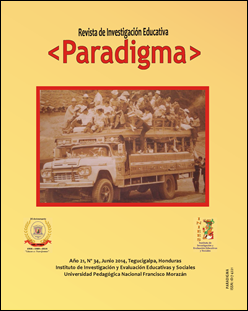Guías de laboratorio de ciencias naturales con diagrama tradicional vrs. guías con diagrama innovador V de Gowin para el tercer ciclo de educación básica
DOI:
https://doi.org/10.5377/paradigma.v21i34.1696Palabras clave:
Laboratorios, aprendizajes significativos, experiencias innovadorasResumen
El proceso de enseñanza-aprendizaje en el aula, es fundamental y requiere de prácticas educativas apropiadas y eficaces, convirtiéndose en un reto difícil para el docente de hoy, porque exige un conjunto de requerimientos específicos como el dominio científico, actitudes, estrategias y acciones que deben conjugarse en un marco de interacción entre los actores. Con el propósito de buscar alternativas en la construcción del conocimiento y aprendizaje de las ciencias naturales, especialmente en el papel que juegan los laboratorios, al innovar, construir conocimientos, procedimientos y adquirir competencias que nos lleven a un aprendizaje significativo, la investigación incursiona a partir de la observación, descripción y de la experimentación que se realiza en el laboratorio de Ciencias Naturales del tercer ciclo del nivel básico, desde una perspectiva tradicional y una innovadora con la presentación del diagrama UVE de Gowin; explorando cuál de las dos trae consigo mayor aprendizaje significativo, funcionalidad, creatividad e innovación.
DOI: http://doi.dx.org/10.5377/paradigma.v21i34.1696
<Paradigma> - Revista de Investigación Educativa. Año 21. No. 34: 133-159
Descargas
2131
Descargas
Publicado
Cómo citar
Número
Sección
Licencia
Cesión de Derechos de Autor
- El autor o autora, al enviar el trabajo, manifiesta que es su voluntad ceder a la Universidad Pedagógica Nacional Francisco Morazán los derechos patrimoniales que le corresponden como autor de su trabajo.
- Los derechos aquí cedidos comprenden todos los derechos patrimoniales (Reproducción, transformación, comunicación pública y distribución) y se dan sin limitación alguna en cuanto a territorio se refiere; esta Cesión se da por todo el término de duración establecido en la legislación vigente en Honduras.
- La cesión de los derechos antes mencionada no implica la cesión de los derechos morales sobre la misma, porque de conformidad con lo establecido en la Ley de Derechos de Autor y Derechos Conexos, Capítulo II, de los Derechos Morales, Artículo 34, Artículo 25, estos derechos son irrenunciables, imprescriptibles, inembargables e inalienables.
- El trabajo de investigación o documento debe ser original y haber sido realizado sin violar o usurpar derechos de terceros, por lo tanto, la obra es de autoría exclusiva y posee la titularidad de la misma.
- En caso de presentarse cualquier reclamación o acción por parte de un tercero, en cuanto a los derechos de autor sobre la obra en cuestión, el autor deberá asumir toda la responsabilidad sobre los derechos cedidos.
- Al completar el Formato de Cesión de Derechos el autor manifiesta que el trabajo no ha sido publicado en otro medio, que los derechos sobre el trabajo no han sido cedidos y que sobre ellos no pesa ningún gravamen ni limitación en su uso o utilización.




